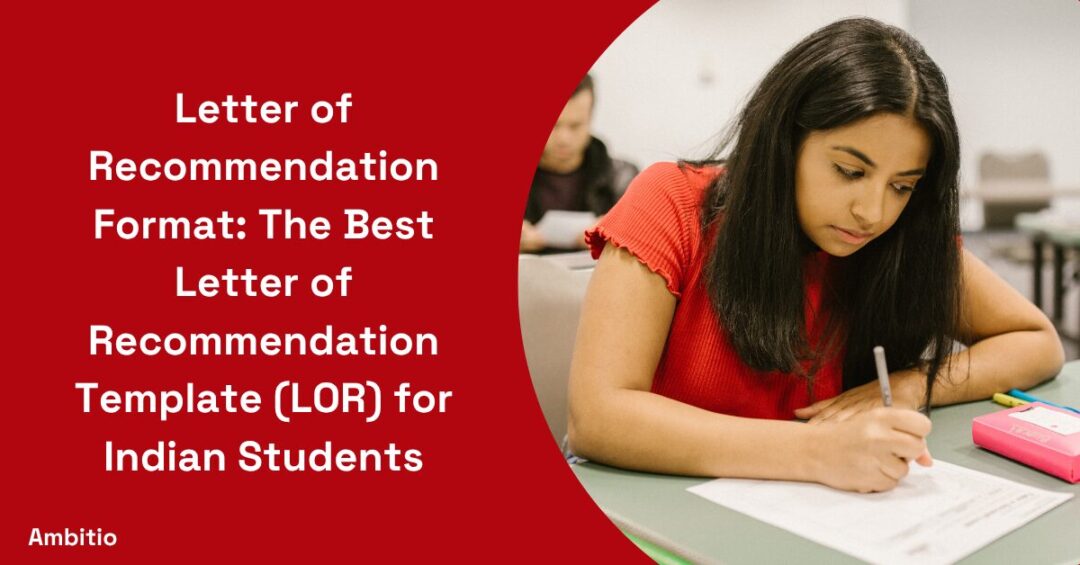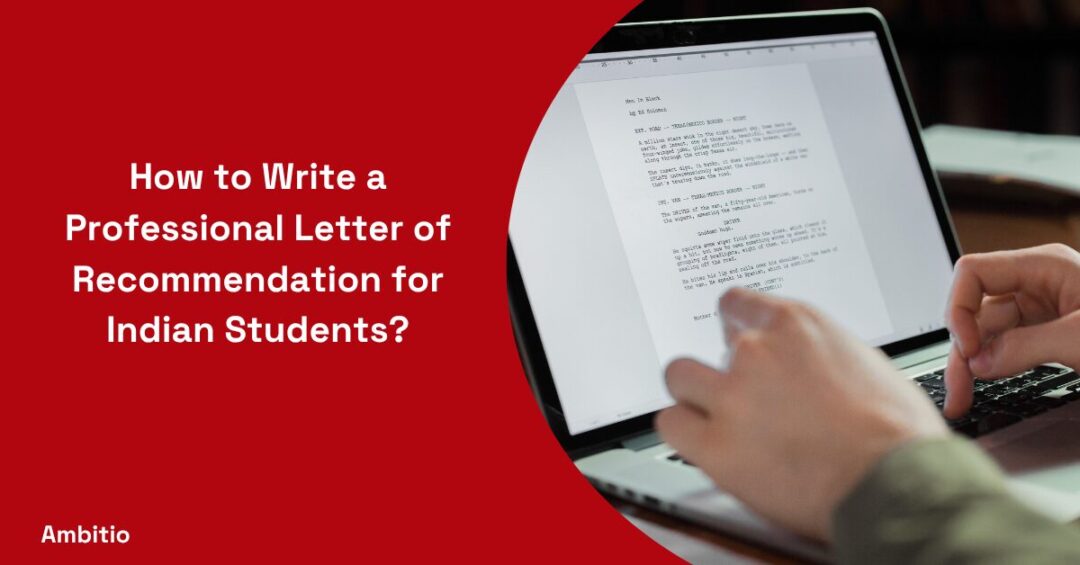13 December 2024
7 minutes read
How to Write a Letter of Recommendation for a Scholarship

The importance of a scholarship in a student’s academic journey is immeasurable, and a letter of recommendation plays a pivotal role in securing this crucial financial support.
This comprehensive guide is designed to walk you through the nuances of crafting an effective and impactful recommendation letter for scholarship applications.
Understanding the Purpose of a Scholarship Recommendation Letter
Why Your Letter Matters
The recommendation letter for a scholarship serves as a testament to the applicant’s qualifications, character, and suitability for the scholarship. It provides the scholarship committee with insights from someone who knows the candidate professionally or academically. This letter can be the difference between a successful application and one that gets overlooked.
Key Components of an Effective Letter
A strong recommendation letter should:
- Clearly establish the relationship between the writer and the applicant.
- Provide specific examples of the applicant’s achievements and skills.
- Reflect on how the applicant meets the scholarship criteria.
- Be professionally formatted and well-written.
The Impact of a Well-Written Recommendation
Making a Lasting Impression
An effectively written letter not only highlights the student’s achievements but also provides a glimpse into their character and potential. This can significantly influence the committee’s decision, especially in competitive scholarship scenarios.
The Power of Specific Examples
General praises fall flat. Your letter should include specific instances and accomplishments that demonstrate the student’s suitability for the scholarship. These concrete examples make your recommendation credible and compelling.
Before You Begin Writing
Gathering Information
Before penning the letter, gather all necessary information about the scholarship and the student. Understand the scholarship’s requirements, criteria, and the qualities they prioritize in a candidate.
Building a Framework for Your Letter
Outline the key points you want to cover. This might include the student’s academic achievements, leadership roles, community service, and personal attributes relevant to the scholarship.
Understanding the Student’s Goals and Aspirations
To write a compelling letter of recommendation for a scholarship, it’s crucial to have a deep understanding of the student’s goals and aspirations. This knowledge allows you to provide specific examples and reasons why the student is a deserving candidate for the scholarship. Here are key points to consider:
- Direct Conversations with the Student:
- Arrange a meeting or a conversation with the student to discuss their future plans.
- Ask about their career aspirations, academic interests, and how the scholarship will help them achieve these goals.
- Reviewing the Student’s Academic and Extracurricular Achievements:
- Look at their academic records, awards, and recognitions to understand their academic strengths.
- Evaluate their involvement in extracurricular activities, clubs, sports, or community service to get a sense of their interests and passions.
- Discussing Long-Term Goals:
- Encourage the student to share their long-term career goals.
- Understand how these goals align with the scholarship and how the scholarship can aid in achieving them.
- Understanding Personal Motivations:
- Ask about personal experiences or challenges that have shaped their ambitions.
- Understanding these motivations can add a personal touch to the letter, making it more heartfelt and genuine.
- Gathering Insights from Other Educators:
- If possible, discuss with other teachers or counselors who know the student well.
- This can provide a more rounded view of the student and additional anecdotes or examples to include in the letter.
- Reflecting on the Student’s Growth:
- If you have known the student for several years, reflect on their growth and development.
- Highlight how they have evolved academically, personally, or in leadership skills.
- Linking Aspirations to Scholarship Requirements:
- Identify how the student’s goals and the scholarship’s focus align.
- Tailor examples in your letter to demonstrate this alignment clearly.
- Acknowledging Challenges and Overcoming Obstacles:
- If applicable, mention any challenges the student has faced and overcome.
- This can showcase resilience and determination, qualities often admired by scholarship committees.
- Discussing Future Contributions:
- Talk about how the student plans to contribute to their field of study, community, or society at large.
- Emphasize the impact that receiving the scholarship would have on these contributions.
- Keeping Notes for Reference:
- Keep notes from your discussions with the student.
- These notes can be valuable references when writing the letter to ensure accuracy and specificity.
Crafting the Content of the Letter
Crafting the content of a scholarship recommendation letter is perhaps the most crucial aspect of your writing endeavor. This section of the letter is where you bring the student’s character, achievements, and potential to life. Here’s how to approach it:
Writing a Captivating Introduction
Begin your letter with an engaging introduction. It should immediately capture the interest of the scholarship committee. Start by introducing yourself, including your professional title and your relationship with the applicant. Your introduction should also establish your credibility and explain why you are qualified to recommend the student.
For example: “As a [Your Title] at [Your Institution or Organization], I have had the pleasure of knowing [Student’s Name] for [X years] in my capacity as [Your Relationship with the Student, e.g., their teacher, mentor, etc.].”
Detailing the Student’s Qualifications and Achievements
This part of the letter is where you delve into the specifics of the student’s achievements and qualifications. Focus on areas that are relevant to the scholarship.
For instance, if the scholarship emphasizes community service, highlight the student’s contributions and leadership in community initiatives. Use specific examples and anecdotes to illustrate these points, as this adds authenticity and depth to your recommendations.
For instance: “In [Year], [Student’s Name] initiated a community project, [Project Name], which successfully addressed [Specific Issue]. This project not only demonstrated [Student’s Name]’s leadership skills but also their deep commitment to social change.”
Highlighting Personal Qualities and Potential
In addition to academic and extracurricular achievements, it’s important to discuss personal qualities that make the student a worthy candidate. Talk about traits such as resilience, empathy, determination, and intellectual curiosity. These personal attributes can be as compelling as academic achievements, if not more.
For example: “[Student’s Name]’s resilience was particularly evident when they [Describe a specific situation]. Despite facing [Specific Challenges], they showed remarkable [Quality, e.g., determination, resourcefulness].”
Showcasing the Student’s Potential
Discuss the student’s potential for future success, which is a critical consideration for most scholarship committees. Emphasize their aspirations, goals, and how the scholarship will aid their academic and career journey. This shows that the student has a clear vision for their future, and the scholarship will be instrumental in achieving it.
For instance: “[Student’s Name] has expressed a deep interest in [Field or Subject]. Their goal to [Specific Goal or Ambition] is not only commendable but a testament to their passion for [Field or Subject]. This scholarship will undoubtedly be a stepping stone towards realizing these ambitions.”
Tailoring the Letter to the Scholarship
When writing a recommendation letter for a scholarship, it is essential to tailor the letter to align with the specific scholarship’s criteria and values. This personalized approach demonstrates that you have taken the time to understand what the scholarship committee is looking for and how the student you are recommending aligns with these attributes. Here’s how to go about it:
Understanding the Scholarship’s Criteria
Before you begin writing, take the time to research the scholarship. Understand its purpose, values, and the qualities they seek in a candidate. Scholarships may focus on various areas such as academic excellence, community service, leadership qualities, or specific talents like artistic or athletic abilities.
For example, if the scholarship is aimed at students who have demonstrated outstanding community service, make sure to highlight the student’s involvement and impact in community activities.
Highlighting Relevant Experiences and Qualities
Once you understand the scholarship’s criteria, select the experiences and qualities of the student that best align with these requirements. If the scholarship values leadership, provide examples of the student’s leadership roles and how they excelled in these positions. Use specific examples and stories to illustrate these qualities, as this will make the letter more compelling.
For instance: “Under [Student’s Name]’s leadership, the student council successfully organized a charity event, raising significant funds for [Cause]. This event not only showcased [Student’s Name]’s organizational skills but also their ability to inspire and motivate their peers.”
Demonstrating the Student’s Fit for the Scholarship
Explain why the student is not just qualified, but an exceptional fit for this specific scholarship. Link their goals, aspirations, and past experiences with what the scholarship offers.
This demonstrates that the student’s receipt of the scholarship would be beneficial both for them and in furthering the objectives of the scholarship program.
For example: “[Student’s Name]’s passion for environmental science aligns seamlessly with the goals of the [Scholarship Name], which supports students committed to environmental conservation.”
Customizing the Tone and Language
The tone and language of your letter should also reflect the spirit of the scholarship. If the scholarship is more formal and academically inclined, use a professional and formal tone. If it’s a creative arts scholarship, a more expressive and enthusiastic tone might be appropriate.
For instance, for a creative arts scholarship, you might say: “[Student’s Name]’s creativity and originality in their art projects have been nothing short of inspirational. Their unique perspective is exactly what the [Scholarship Name] seeks to nurture and develop.”
Finalizing Your Letter
Polishing the Letter Ensure your letter is well-organized, free from errors, and professionally formatted. A well-presented letter reflects positively on both you and the applicant.
Closing with a Strong Endorsement Conclude with a strong statement of recommendation. Reinforce your confidence in the student’s abilities and their fit for the scholarship.
The Importance of a Professional Tone and Format
Maintaining Professionalism Use a formal tone throughout the letter. This conveys respect for the process and the seriousness of your endorsement.
Adhering to Formatting Standards Typically, a recommendation letter should be no longer than a page, use a professional font, and be printed on official letterhead if available.
Conclusion
Writing a letter of recommendation for a scholarship is a significant responsibility. By following this guide, you can craft a letter that not only highlights the student’s achievements and potential but also resonates with the scholarship committee, enhancing their chances of success.
Remember, your letter is not just a formality; it’s a powerful tool that can open doors for deserving students. Your thoughtful and well-crafted words can be the key to unlocking educational opportunities and helping shape a student’s future.
FAQs
How can I personalize a recommendation letter without losing professionalism?
While maintaining a formal tone, include personal anecdotes and specific examples that showcase the student’s unique qualities and achievements.
Is it appropriate to discuss a student’s personal challenges in the letter?
If relevant, discussing how the student has overcome personal challenges can demonstrate resilience and determination, but ensure focus on their growth and positive outcomes.
Can I write a recommendation letter for multiple scholarships?
Yes, but customize each letter to address the specific criteria and focus of each scholarship.
How do I handle a request for a recommendation if I don’t know the student well?
Politely decline if you cannot provide a detailed and genuine endorsement. A lackluster or generic letter can do more harm than good.
What should I avoid in a scholarship recommendation letter?
Avoid vague statements, generic praises, and any information that doesn’t directly support the student’s candidacy for the specific scholarship.

You can study at top universities worldwide!
Get expert tips and tricks to get into top universities with a free expert session.
Book Your Free 30-Minute Session Now! Book a call now




























